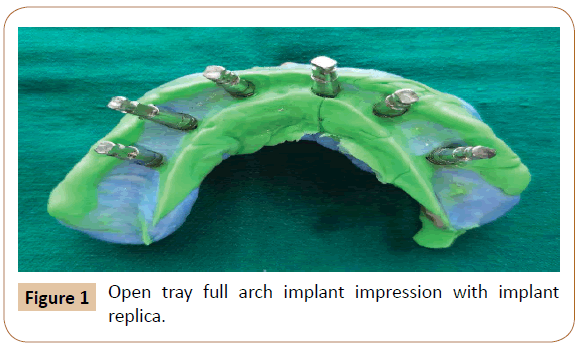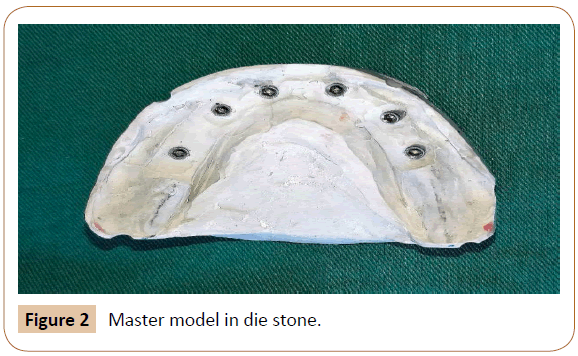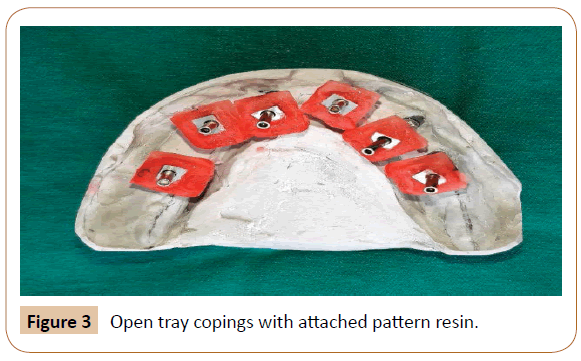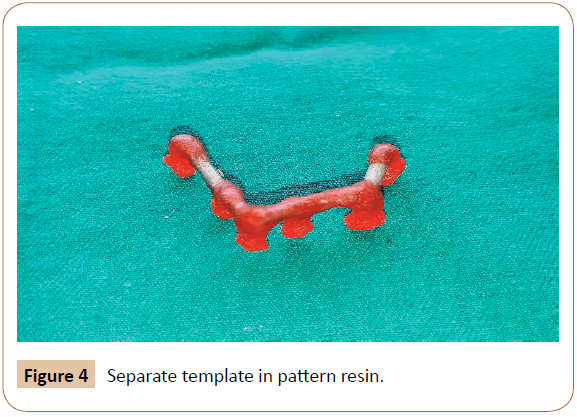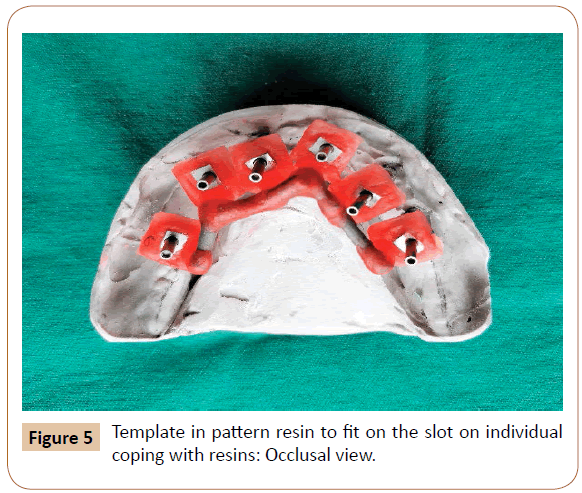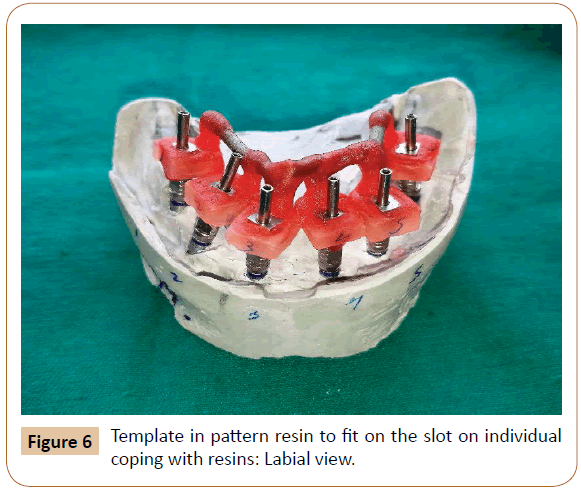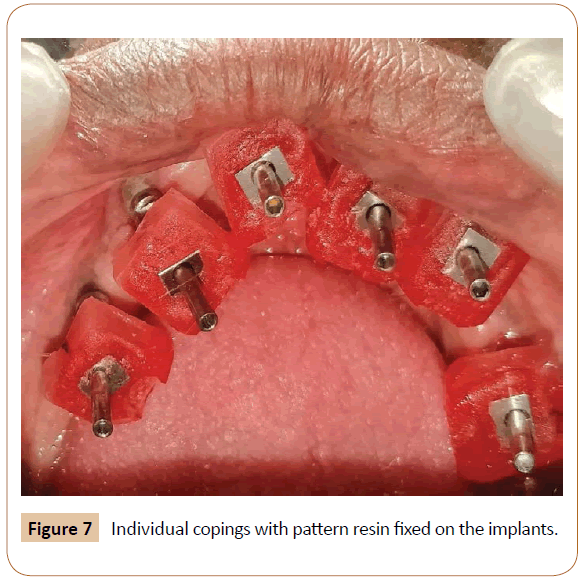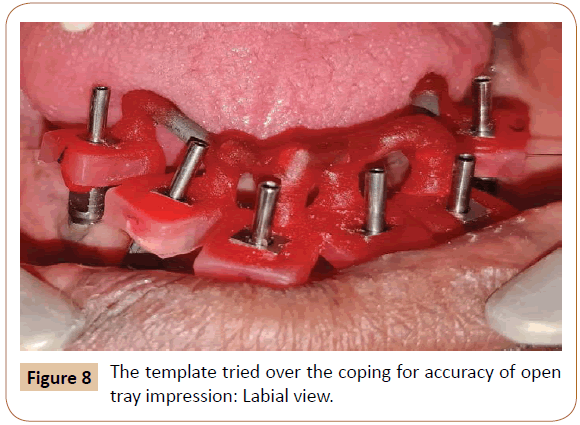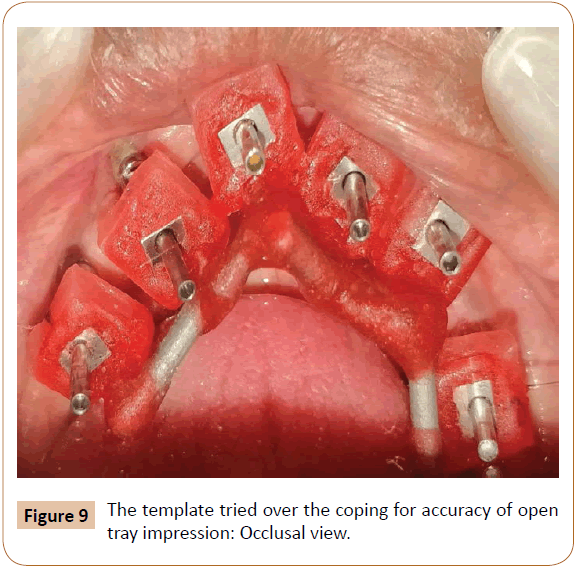Dr. Haby Mathew Somson*
Department of Prosthodontics, Pushpagiri College of Dental Sciences, Tiruvalla, Kerala, India
- *Corresponding Author:
- Dr. Haby Mathew Somson
Senior Lecturer, Department of Prosthodontics, Pushpagiri College of Dental Sciences, Tiruvalla, Kerala, India
Tel: +0091 9961719933
E-mail: drhabyms@gmail.com
Received Date: September 03, 2019; Accepted Date: September 23, 2019; Published Date: October 03, 2019
Citation: Somson HM (2019) Fabrication of Verification Jig for Full Arch Implant Supported Fixed Prosthesis – A Novel Technique. Periodon Prosthodon Vol.5 No.1:47.
Keywords
Fabrication; Dental implant; Innovative method
Introduction
The demands for implant supported fixed prosthesis is on the rise, and so is the need for expertise in more accurate procedures. After the surgical placement of implants, accurate transfer of inter-implant positions, use of open tray impression copings with splinting and without splinting has been in practice. Studies have favored open tray impression techniques in which implants are splinted together with resins. After the impression is made in polyvinyl siloxane impression material, the master model is prepared. Conventionally, a single assembly of splinted copings is used as a verification jig to confirm the accuracy of the impression intraorally over the osseo-integrated implants. Placing the splinted assembly may be a challenge in certain cases, as factors like polymerization shrinkage of the acrylic resin is inevitable. A major problem faced may be lack of a passive fit of the splinted assembly when the verification jig is placed intraorally. This may be worse in situations where the implants are non-parallel [1-3]. This article describes a simple, yet precise method of fabrication of a verification jig for full arch implant supported fixed prosthesis for maxillary and mandibular arches [4-8].
Methods
1. Prepare a custom tray for a full arch impression (Rapid Repair; Dentsply Intl, Milford, Del)
2. Make an open tray impression in Polyvinyl siloxane (Aquasil, Dentsply Intl) (Figure 1).
3. Pour the model in Die Stone (Figure 2).
4. Separate the copings from the impression.
5. Place individual open tray copings on the model and tighten it accurately.
6. Adapt auto-polymerising acrylic resin (Pattern Resin GC America) on the impression coping in a specific manner that creates a slot or female component parallel to vertical axis, on the lingual or palatal side (Figure 3).
7. Mark an indication line on the cast corresponding to the slot. This will help in orienting the copings intra orally during verification step.
8. Apply petroleum jelly on the prepared resin surface.
9. Fabricate a separate template in resin with a male component for each slot on individual copings (Figure 4).
10. Check if template is accurately seated in a single path of insertion on all the individual copings (Figures 5 and 6).
11. The verification jig is ready to be used intra orally over the implants.
12. Seat the individual copings with the resin over the implants with precise orientation. (Figure 7).
13. Check for the uni-directional path of insertion of the template, thereby, the accuracy of open tray impression can be verified (Figures 8 and 9).
Figure 1: Open tray full arch implant impression with implant replica.
Figure 2: Master model in die stone.
Figure 3: Open tray copings with attached pattern resin.
Figure 4: Separate template in pattern resin.
Figure 5: Template in pattern resin to fit on the slot on individual coping with resins: Occlusal view.
Figure 6: Template in pattern resin to fit on the slot on individual coping with resins: Labial view.
Figure 7: Individual copings with pattern resin fixed on the implants.
Figure 8: The template tried over the coping for accuracy of open tray impression: Labial view.
Figure 9: The template tried over the coping for accuracy of open tray impression: Occlusal view.
Results and Discussion
The technique described above is a novel and efficient method for fabrication of an intraoral verification jig with pattern resin which can be easily placed on the osseo-integrated implant. The advantages of this method are that it allows trouble free placement of impression copings on the implants and is a more precise way of checking the accuracy of the impression with the template. This technique proves useful in situations where the implant angulations on a full arch maxilla or mandible are not favorable otherwise.
Conclusion
This technique utilizes open tray impression copings on each implant replica on the master models on which pattern resin is adapted in a unique manner with a slot. This method provides easy verification of accuracy of implants intraorally than the conventional techniques.
References
- Wee AG (2000) Comparison of impression materials for direct multi-implant impressions. J Prosthet Dent 83: 323–331.
- Carr AB (1991) A comparison of impression techniques for a five-implant mandibular model. Int J Oral Maxillofac Implants 6: 448–455.
- Jemt T, Rubenstein JE, Carlsson L, Lang BR (1996) Measuring fit at the implant prosthodontic interface. J Prosthet Dent 75: 314–325.
- Carr AB (1992) Comparison of impression techniques for a two implant 15-degree divergent model. Int J Oral Maxillofac Implants 7: 468–475.
- Hsu CC, Millstein PL, Stein RS (1993) A comparative analysis of the accuracy of implant transfer techniques. J Prosthet Dent 69: 588–593.
- Inturregui JA, Aquilino SA, Ryther JS, Lund PS (1993) Evaluation of three impression techniques for osseointegrated oral implants. J Prosthet Dent 69: 503–509.
- Phillips KM, Nicholls JI (1994) The accuracy of three implant impression techniques: A three-dimensional analysis. Int J oral Maxillofac Implants 9: 533–540.
- Spector MR, Donovan TE, Nicholls JI (1990) An evaluation of impression techniques for osseointegrated implants. J Prosthet Dent 63: 444–447.

